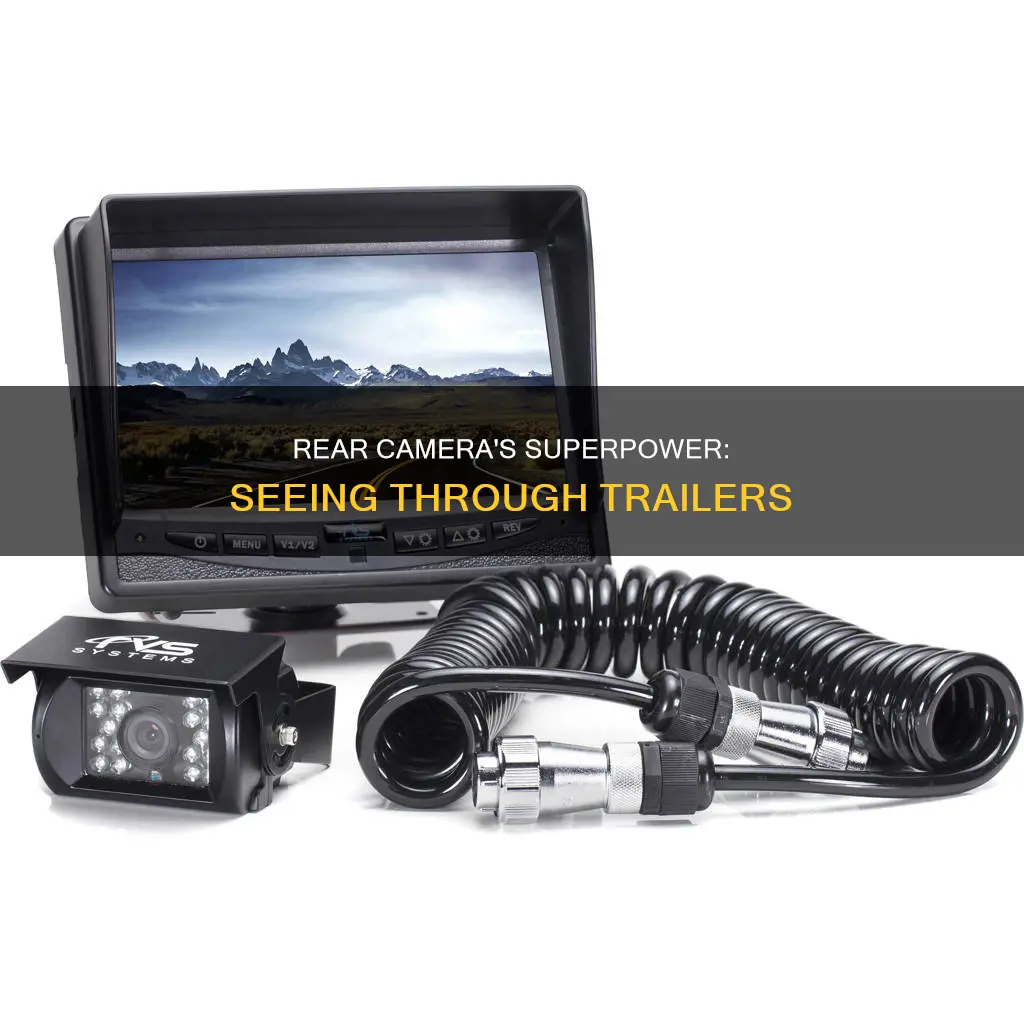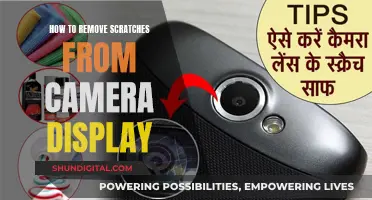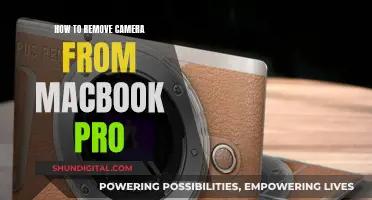
The latest truck technology includes rear cameras that can see through trailers. This feature is designed to improve safety and visibility, especially when towing large loads. The see-through camera combines the outputs of the reversing camera and the trailer-mounted rearview camera to let drivers see through their trailer as if it's not there. This allows them to see any vehicles that are directly behind the trailer and improves their ability to navigate tight spaces, merge into traffic, or make turns.
| Characteristics | Values |
|---|---|
| Camera views | 15 |
| Camera angles | 15 |
| Camera system | ProGrade Trailering Camera System |
| Camera placement | Rear of the vehicle, sides of the vehicle, and back of the trailer |
| Camera function | Image stitching, perspective correction, and object detection |
| Camera activation | Vehicle in reverse gear or driver manually selects camera view |
| Display | Monitor or touchscreen interface inside the vehicle |
| Vehicles | 2020 Chevrolet Silverado 1500, 2020 Silverado 2500 HD, 2019 GMC Sierra 1500, 2020 Sierra 2500, 2020 Sierra 3500, 2020 GMC Sierra HD |
What You'll Learn

The ProGrade Trailering Camera System
One of the standout features of the ProGrade Trailering Camera System is the "see-through" trailer camera, which revolutionizes how drivers navigate with a trailer in tow. This multi-camera system utilizes up to 15 different camera angles, including three front and four rear camera angles for the truck, as well as a camera mounted on the trailer. The system can automatically switch angles when it detects potential obstacles, or drivers can manually select the desired view.
The transparent trailer view is made possible by combining the feeds from the reversing camera and the trailer-mounted rearview camera. This technology overlays the images, allowing drivers to see through the trailer as if it were invisible. This feature significantly improves safety by providing a clear view of any vehicles directly behind the trailer, eliminating blind spots, and enabling safer lane changes and reversing.
In addition to the transparent view, the ProGrade Trailering Camera System offers a range of other valuable camera angles. This includes a wide-angle rear surround view, a bowl angle that shows the truck from a few feet in front, a hitch view for precise coupling, and an interior trailer view. The system also provides dynamic gridline overlays and a top-down view of the hitch, making it easier for drivers to line up their trailers without the need for a spotter.
Trail Camera's Bat Vision: What They See After Dark
You may want to see also

How the camera system works
The rear camera system that sees through trailers is an advanced technology designed to improve safety and visibility for drivers towing large vehicles. This technology combines the outputs of multiple cameras and software algorithms to provide drivers with a clear view of their surroundings, including the area behind the trailer, which is usually out of sight.
The camera system typically consists of multiple high-definition cameras strategically positioned on the vehicle and trailer to capture a 360-degree view of the surroundings. These cameras are usually mounted on the rear and sides of the vehicle and the back of the trailer, providing comprehensive coverage of blind spots. The footage from these cameras is then fed to a central processing unit, which combines and processes the images to create a composite view of the vehicle and its surroundings.
The system's software algorithms play a crucial role in enhancing the video streams from the individual cameras. They perform tasks such as image stitching, perspective correction, and object detection to create a seamless and detailed composite view. Additionally, the software may incorporate features such as distance markers, trajectory lines, and warning alerts to assist drivers in making informed decisions and executing maneuvers with precision.
The resulting composite view is then displayed on a monitor or touchscreen interface inside the vehicle's cabin, providing drivers with a detailed and accurate representation of their surroundings in real time. This allows drivers to monitor their surroundings, identify potential obstacles, and make informed decisions about maneuvering, reversing, or parking their vehicle and trailer safely.
The see-through camera system is a valuable feature, especially when towing large trailers or maneuvering in tight spaces. It enhances overall driving safety by improving visibility, reducing blind spots, and providing drivers with a clear view of the road behind the trailer. This technology empowers drivers to navigate challenging conditions with confidence and precision, ultimately improving the towing experience and promoting road safety.
Apple Watch Camera Models: Which Ones Have It?
You may want to see also

Camera placement
One option is to mount the camera on the bumper or rear of the trailer. This provides a direct view of the road behind, but it may be necessary to angle the camera upwards to avoid obstructions such as the trailer's bumper or hitch. This type of placement is commonly used for wireless cameras, as it allows for a clear line of sight between the camera and the receiver in the towing vehicle.
Another option is to mount the camera higher up on the trailer, such as on the roof or side mirrors. This can provide a wider field of view and reduce the impact of blind spots caused by the trailer. However, it is important to consider the height and angle of the camera to ensure it is not obstructed by the trailer's walls or roof. This type of placement is often used for wired camera systems, as it may be easier to run cables along the trailer's frame or walls.
When positioning the camera, it is important to consider the camera's field of view and adjust it to cover the desired area. For example, a camera placed high up on the trailer may need to be tilted downwards to cover the area directly behind the trailer. Additionally, it is recommended to avoid mounting the camera too close to running lights or other light sources to prevent glare or reflection issues.
In some cases, it may be preferable to install the camera inside the trailer, looking out through a rear window. This can protect the camera from the elements and potential theft. However, it is important to consider the type of camera used, as infrared cameras may not function properly due to the reflection of infrared rays off the window glass.
Overall, the placement of the rear-view camera will depend on the specific needs and constraints of the trailer and towing vehicle. It may be necessary to adjust the camera position and angle to ensure a clear and unobstructed view of the road behind the trailer.
Neighborhood Watch: Cameras Keep a Close Eye
You may want to see also

Displaying the camera feed
The camera feed is typically displayed on a touchscreen or a monitor integrated into the vehicle's dashboard. In some cases, the feed may be displayed on a separate screen attached to the rearview mirror. The screen provides a comprehensive view of the surroundings, including the trailer's interior, the hitch, and the road behind the trailer.
The ProGrade Trailering Camera System, offered by certain truck manufacturers, provides up to 15 different camera angles to improve visibility. These angles can be switched manually or automatically when the system detects potential obstacles. The system includes front, rear, hitch, and bed camera angles, as well as the transparent see-through camera view.
To achieve the transparent trailer view, the system lines up the images from the trailer-mounted camera and the reversing camera. It then detects the edges of the trailer and outlines it, creating a transparent image. This allows drivers to see any vehicles directly behind the trailer as if the trailer were not there.
The display screen not only shows the camera feed but also provides additional information such as navigation, speed, and incline data. This integrated approach enhances the driver's awareness and decision-making while manoeuvring or driving on the road.
Cameras Behind the Scenes of End of Watch
You may want to see also

Limitations and challenges
The "see-through" trailer camera system, also known as the Transparent Trailer View, is a groundbreaking innovation in trailer safety. However, it does come with certain limitations and challenges that users should be aware of. One of the main limitations is compatibility; the system requires a properly equipped truck, a compatible trailer, and a specific installation process for the accessory camera. Not all trailers are compatible with the system, and users should consult their dealer for specific details. Additionally, the system currently works with trailers up to 32 feet in length, which may exclude some larger trailers.
Another challenge is the installation process. While the camera system offers multiple viewpoints, it requires careful calibration to function effectively. Users must measure and enter their trailer's exact dimensions into the system, following specific guidelines. This process ensures that the camera angles align correctly, providing an accurate view of the area behind the trailer. Improper calibration could result in inaccurate or distorted images, reducing the effectiveness of the system.
Furthermore, the camera system relies on multiple cameras working in conjunction. This includes cameras mounted on the truck itself and an additional camera installed on the back of the trailer. Any issues with these cameras, such as damage or malfunction, could impact the overall performance of the system. Regular maintenance and proper care of the cameras are essential to ensure their functionality.
It is also important to note that while the "see-through" trailer camera system enhances visibility and safety, it does not replace the driver's responsibility to operate the vehicle safely. Drivers should remain vigilant and utilize the system as a tool to assist in decision-making, rather than solely relying on the camera views. The system may also require an upgrade to a larger touchscreen to fully utilize all the camera angles provided.
Lastly, the "see-through" trailer camera system is a recent innovation, and as with any new technology, there may be unforeseen challenges or limitations that emerge over time. User feedback and ongoing development will play a crucial role in addressing these potential issues and improving the system's performance and compatibility.
How Teleprompter Beam Splitters Affect Camera Images
You may want to see also
Frequently asked questions
The rear camera sees through the trailer by combining the outputs of the reversing camera and the trailer-mounted rearview camera.
#
The camera system captures live video footage of the surrounding environment through multiple cameras mounted on the vehicle and trailer. These video streams are then fed to a central processing unit, which combines and processes the images to create a composite view.
#
The primary purpose of this technology is to improve visibility and safety while towing by eliminating blind spots and providing drivers with a clear view of the road behind the trailer.
#
The camera system helps drivers make informed decisions and execute maneuvers with confidence, ultimately reducing the risk of accidents, collisions, or damage to the trailer and surrounding vehicles.
#
This feature is available on select Chevy and GMC vehicles, including the 2020 Chevrolet Silverado 1500, 2020 Silverado 2500 HD, 2019 GMC Sierra 1500, 2020 Sierra 2500, and 2020 Sierra 3500.







